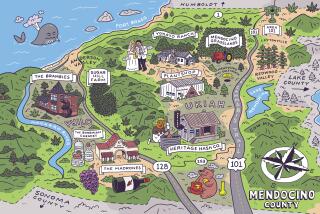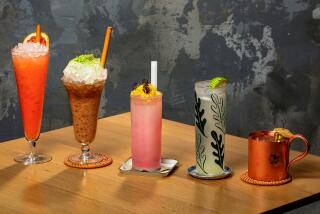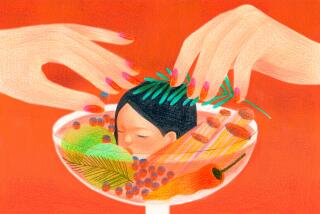Teacher’s Spirited Quest Pays Off
Fine wines and spirits have long been identified by their home regions, taking names with such cachet that their use by others is either barred by law or disdained by devotees. Champagne must be from Champagne, or it is merely sparkling wine. Scotch must be from Scotland, Tequila from Tequila.
So, how about savoring a snifter of Irwindale?
The city known for its gravel pits and its failed courtship of the Raiders--the city that was recognized by McDonald’s for leading the nation in Big Mac consumption--is now the toast of Los Angeles County as the home of premium-quality brandy and whiskey.
Although Jim Busuttil opted against naming his pricey spirits for their hometown, his Irwindale micro-distillery--tucked inside an industrial park across the street from a motor home maintenance lot--has produced a cherry brandy that won first place at the Los Angeles County Fair.
It is here, inside his St. James Spirits distillery that Busuttil is brazenly attempting a craft that some insist takes centuries to refine.
‘Distilling Is My Passion’
Even more intriguing to purists is his rejection of the mythology that the flavor of spirits is influenced by their natural surroundings.
Busuttil had an important reason for picking the spot: It is near his day job as a biology teacher at Mountain View High School in El Monte.
“Distilling is my passion,” he said, explaining his effort against seemingly long odds.
Busuttil is one of only a few individual distillers in the United States, according to John Hansell, publisher of Malt Advocate, a magazine covering whiskey and micro-brewery beers.
But Hansell said Busuttil might soon be followed by others.
“Micro-distilling could be the trend of the future,” he said.
Although sales of distilled spirits have been flat or declining for years, purchases of high-end spirits are surging, with many bars and restaurants now offering Scotch and Tequila tastings.
Hansell said the numerous U.S. beer microbreweries that have sprung up in the last five years could start making whiskey.
“There’s a lot of experimenting going on,” he said, but in the highly competitive niche industry “people aren’t talking a lot about it.”
Working alone after school, Busuttil distills just seven products--three fruit brandies, a rum, his agave (the plant from which Tequila is made) spirit and the yet-to-be released grappa and single malt whiskey. Busuttil’s entire output in the three years he’s been in business wouldn’t fill a single liquor store.
At this rate, he is not likely to get rich. He hopes to someday earn enough to quit teaching summer school and use the vacation period to distill full time.
Busuttil’s passion for distilling was ignited on his honeymoon in 1987. Visiting his wife’s family farm in Switzerland, he witnessed an annual harvest rite. A truck carrying a still drove from farm to farm, distilling cherries and other just-picked fruits into Kirsch, a Swiss fruit brandy.
Intrigued, Busuttil spent several school breaks traveling through Germany and Switzerland taking lessons from master distillers. He also toured whiskey distilleries in Scotland one summer, gathering pointers from master distillers as he drove across the country in a rented car with his mother, who grew up there.
In Scotland he was able to see enough to separate fact from fiction in the distilling process.
He was told, for instance, that one whiskey maker pounded a dent in a new still in the same spot where the old one was dented in a superstitious attempt to ensure consistency.
Busuttil also visited the springs and wells that many distilleries hype as providing water that produces superior whiskey.
He wasn’t impressed.
“I’ve seen some of those places, and I wouldn’t swim in that water,” he said.
Busuttil’s water is a mixture of tap water and distilled water he buys in plastic jugs at the market.
Returning to the United States, he saved money to buy his own still, which he brought back from Germany, and he opened his Irwindale distillery in 1995.
Although he’s traveled the world in his quest to produce the perfect spirits, he admits he doesn’t enjoy drinking very much.
“It’s like a big science project for me,” he said of his avocation.
Whiskey Must Age for 3 Years
Busuttil’s father, David, a Maltese immigrant whose family had made wine on its farm for generations, worked with him for two years before dying of prostate cancer. Their first product was a cherry Kirsch, which Busuttil did not bottle because he was too disturbed by his father’s death.
Instead, he turned to other products--pineapple and pear brandies, a pineapple-flavored rum, grappa and his agave liquor and whiskey.
With Tequila and Scotch off-limits as names, Busuttil called his agave drink California Gold Agave, and his whiskey Peregrine Rock California Pure Single Malt. His agave sells for $21 per 375-milliliter bottle at specialty liquor stores and swanky supermarkets such as Bristol Farms.
The whiskey won’t be sold for another year, because California law requires a minimum three years of aging.
Busuttil said California’s high temperatures allow whiskey to be ready in three years instead of the 10 or more of maturing common in Scotland.
It was the cherry Kirsch that he made with his father that brought him his sweet victory at the 1998 Los Angeles County Fair.
Whether or not the business takes off, Busuttil said it has already been worthwhile. “I got to see my father every day for the last two years of his life,” he said.
More to Read
Eat your way across L.A.
Get our weekly Tasting Notes newsletter for reviews, news and more.
You may occasionally receive promotional content from the Los Angeles Times.










